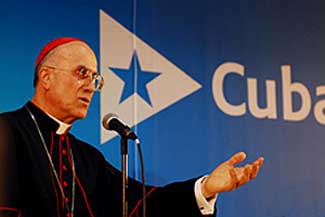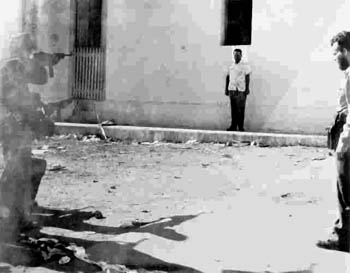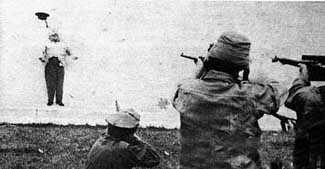 |
International Affairs
Cardinal Bertone and Castro's Fraudulent
“Religious Policy”
Armando Valladares
Shortly after his recent visit to Cuba, Cardinal Tarcisio Bertone, Vatican Secretary of State, granted a long interview to L’Osservatore Romano, official organ of the Holy See (March 1, 2008). In it, the Cardinal contradicts the true history and reality of our days when he affirms that the Church in Cuba, despite “some difficulties” and “limitations,” in reality “is not a persecuted Church” but a “normal Church, like that in so many other countries.”

Bertone: in Cuba there is no persecuted Church |
I learned of these statements after I had written the article Benedict XVI and Cardinal Bertone’s Trip to Cuba, in which I analyzed the enigmatic Vatican policy of déténte (reconciliation) with the tyranny of the Caribbean that has continued for almost five decades, a continuity that inescapably includes the pontificate of Benedict XVI.
It is for me an obligation of conscience to analyze this new grave statement of Bertone by presenting some historical specifics, albeit in a summary fashion.
In the first years of the Revolution, the anti-religious hatred of the Castro regime manifested itself in the expulsion of hundreds of priests and religious, the closing of churches, and the expropriation of Catholic universities and schools.
It reached its summit with the assassinations of anti-Communists, shot against the infamous paredón [great wall] of the prison of Havana. Among the victims were young Catholics who gave their lives shouting “Viva Cristo Rey! Down with Communism!” In my Memoirs, I narrate how those shouts, which I myself heard every night, shook the centuries-old walls of that fortress, but above all shook the hearts of the prisoners, confirming the adage “The blood of martyrs is the seed of new Christians.” The Communist regime quickly perceived this and ordered the jailers to gag those condemned to die.
That gagging was both a symbol of Castro’s fear of the Christian martyrs and of a strategic change that soon followed. The goal changed to that of creating apostates instead of martyrs, as demonstrated in the book The Passion of Christ in Cuba, written by a young banished priest and published in 1962 by the Archbishop of Santiago of Chile. It deals with the regime’s decision to avoid the “errors” committed in the Eastern countries under Communism and in Spain in the ‘30s by the massive assassinations of Catholics.

Above, a Catholic shot for his opposition to the regime
Below, the brutal murder of Col. Cornelio Rojas

The Real Cuba website |
Castro himself acknowledged this change of strategy in a speech in the mid-1960s delivered in the University of Havana, the same institution where, 40 years afterward, a pastor from Rome, Cardinal Bertone, would speak conciliatory words regarding the red wolves. On that occasion Castro said, “We will not fall into the historical error of sowing our pathway with Christian martyrs, because we understand perfectly that it was precisely martyrdom that gave strength to the Church. We will make apostates, thousands of apostates…” (Juan Clark, Cuba: Mito y Realidad, Miami-Caracas: Saeta, 1990, pp. 358, 658).
Thence began decades of the application of “diabolical methods,” the expression used by exiled Cuban Bishop Eduardo Boza Masvidal, to achieve the loss of the faith and obtain the desired apostasies. Cuban schools and universities came to be refined laboratories of atheism and apostasy. Today, in his interview to L’Osservatore Romano, Cardinal Bertone incredibly refers to those same institutions as “the renowned higher education centers and universities that Cuba possesses.”
In the ‘80s, the Brazilian Dominican Friar Betto improved the efficacy of that anti-religious strategy, explaining to dictator Fidel Castro and his Cuban Communist cohorts, that it would be more useful to suggest that “the Church integrate herself into the process of constructing a Socialist society” (Prisma Latinoamericano, No. 160, La Habana, 1985).
In 1986, the National Cuban Church Meeting (ENEC) took place in Havana, which opened an unprecedented stage of lamentable collaboration and “agreement” in “fundamental objectives” between the Pastors and Wolves of Cuba. The 22 years that passed between the ENEC meeting and the recent trip of Cardinal Bertone to Cuba have been marked by this enigmatic Vatican policy of déténte with the Caribbean tyranny, which I referred to in my last article, a process that I have had occasion to analyze in numerous articles.
The present day apprehension of the Catholic Cuban faithful on the island and in exile regarding the collaborationist attitude of their Pastors is not new. It is not by chance that during the realization of ENEC, then-Archbishop of Cuba Pedro Meurice recognized this: “They considered us a Church of martyrs, and now some say that we are a Church of traitors” (La Voz Católica, Archdiocese of Miami, March 14, 1986).

Posted March 20, 2008
Armando Valladares, a former Cuban political prisoner,
was U.S. Ambassador to the U.N. Commission on Human Rights in Geneva
during the Reagan and Bush administrations.
Contact the author at:
Armandovalladares2005@yahoo.es

Related Topics of Interest
 Benedict XVI and Cardinal Bertone’s Trip to Cuba, Benedict XVI and Cardinal Bertone’s Trip to Cuba,
 In Cuba Card. Bertone Attacks American Embargo In Cuba Card. Bertone Attacks American Embargo
 CELAM in Cuba: Cordial Dialogue Between Wolves and Shepherds CELAM in Cuba: Cordial Dialogue Between Wolves and Shepherds
 The Cuban Fiasco The Cuban Fiasco
 JPII, Cuba and a Problem of Conscience JPII, Cuba and a Problem of Conscience
 Declaration of Resistance to the Vatican Ostpolitik Declaration of Resistance to the Vatican Ostpolitik

 
|
International Affairs | Hot Topics | Home | Books | CDs | Search | Contact Us | Donate

© 2002- Tradition in Action, Inc. All Rights
Reserved
|
 |
|